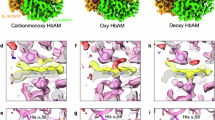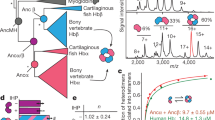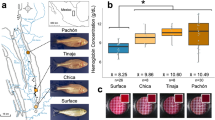Abstract
It is generally accepted that the sigmoidal nature of the haemoglobin–oxygen dissociation curve (ODC) is necessary for efficient oxygen transport in terrestrial vertebrates because it allows large volumes of oxygen to be bound or released for relatively small changes in the partial pressure of oxygen() in the blood. Furthermore, the amount of oxygen to tissues is increased by hydrogen ions produced from the dissociation of carbon dioxide in solution1,2. The generality of these key features of cooperative oxygen binding and the Bohr effect holds for reptiles, birds and mammals3–7, including representatives with special respiratory requirements for diving8–11, burrowing12,13 and living at high altitude14,15. Sphenodon punctatus is the sole surviving representative of the ancient order of ‘beakhead’ reptiles (order Rhynchocephalia) which were once widely distributed during the Triassic period before the spectacular radiation of dinosaur faunas. We have now investigated the oxygen transporting properties of blood from Sphenodon and find that the ODC is hyperbolic, with a high affinity for oxygen and very small Bohr effect. This combination of characteristics is unique among terrestrial vertebrates and accords with a low demand for oxygen and limited scope for aerobic activity.
This is a preview of subscription content, access via your institution
Access options
Subscribe to this journal
Receive 51 print issues and online access
$199.00 per year
only $3.90 per issue
Buy this article
- Purchase on SpringerLink
- Instant access to full article PDF
Prices may be subject to local taxes which are calculated during checkout
Similar content being viewed by others
References
Perutz, M. F. Nature 228, 726–739 (1970).
Perutz, M. F. Scient. Am. 239, 66–86 (1978).
Wood, S. C. & Lenfant, C. in Evolution of Respiratory Processes (ed. Lenfant, C.) 193–223 (Dekker, New York, 1979).
Isaacks, R. E. & Harkness, D. R. Am. Zool. 20, 115–129.
Lutz, P. L. Am. Zool. 20, 187–198 (1980).
Pough, F. H. Am. Zool. 20, 173–185 (1980).
Lapennas, G. N. & Lutz, P. L. Respir. Physiol. 48, 59–74 (1982).
Wood, S. C. & Johansen, K. J. comp. Physiol. 89, 145–158 (1974).
Meyer, M., Holle, J. P. & Scheid, P. Pflügers Arch, ges. Physiol. 376, 237–240 (1978).
Jelkmann, W. & Bauer, C. Comp. Biochem. Physiol. 65A, 331–336 (1980).
Kooyman, G. L., Castellini, M. A. & Davis, R. W. A. Rev. Physiol. 43, 343–356 (1981).
Lechner, A. J. J. appl. Physiol. 41, 168–173 (1976).
Johansen, K., Abe, A. S. & Weber, R. E. J. exp. Zool. 214, 71–77 (1980).
Lenfant, C. Am. Zool. 13, 447–456 (1973).
Black, C. P. & Tenney, S. M. Respir. Physiol. 39, 217–239 (1980).
Barwick, R. E. in New Zealand Herpetology (ed. Newman, D. G.) 225–236 (New Zealand Wildlife Service, Wellington, 1982).
Newman, D. G., Crook, I. G. & Moran, L. R. Int. zool. Yb. 19, 1–7 (1979).
Dacie, J. V. & Lewis, S. M. Practical Haematology (Livingstone, Edinburgh, 1975).
Saint Girons, M. C. in Biology of the Reptilia (ed. Gans, C.) (Academic, New York, 1970).
Cashel, M., Lazzarini, R. A. & Kalbacher, B. J. Chromatogr. 40, 103–109 (1969).
Johansen, K., Lykkeboe, G., Weber, R. E. & Maloiy, G. M. O. Respir. Physiol. 27, 335–345 (1976).
Sigma Technical Bulletin No. 35-UV (1980).
Bartlett, G. R. Analyt. Biochem. 124, 425–431 (1982).
Bartlett, G. R. Comp. Biochem. Physiol. 61A, 191–202 (1978).
Riggs, A. Meth. Enzym. 76, 5–29 (1981).
Sullivan, B. Chem. Zool. 9, 377–398 (1974).
Wood, S. C., Lykkeboe, G., Johansen, K. Weber, R. E. & Maloiy, G. M. O. Comp. Biochem. Physiol. 59A, 155–160 (1978).
Lutz, P. L. & Lapennas, G. N. Respir. Physiol. 48, 75–87 (1982).
Coates, M. L. J. molec. Evol. 6, 285–307 (1975).
Schmidt-Nielsen, K. How Animals Work (Cambridge University Press, 1972).
Tucker, V. A. J. exp. Biol. 44, 77–93 (1966).
Willnow, I. & Willnow, R. Acta anat. 94, 504–519 (1976).
Lapennas, G. N., Colacino, J. M. & Bonaventura, J. Meth. Enzym. 76, 449–470 (1981).
Jelkmann, W. & Bauer, C. Analyt. Biochem. 75, 382–388 (1976).
Benesch, R. E., Benesch, R. & Yung, S. Analyt. Biochem. 55, 245–248 (1973).
Severinghaus, J. W. in Handbook of Respiration and Circulation (eds Altman, P. L. & Dittmer, D. S.) 218–219 (Fed. Am. Exp. Biol., Bethesda, 1971).
Author information
Authors and Affiliations
Rights and permissions
About this article
Cite this article
Wells, R., Tetens, V. & Brittain, T. Absence of cooperative haemoglobin–oxygen binding in Sphenodon, a reptilian relict from the Triassic. Nature 306, 500–502 (1983). https://doi.org/10.1038/306500a0
Received:
Accepted:
Issue Date:
DOI: https://doi.org/10.1038/306500a0



